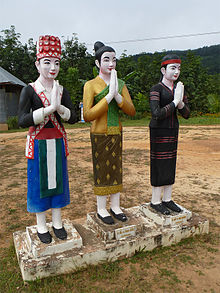Lao Theung

The Lao Theung (in Lao : ລາວ ເທິງ , ALA-LC : lāo thœng , pronunciation: [láːw tʰɤŋ] , "mountainside Laotians") are one of the three government-defined categories of the population of Laos . These are not primarily defined ethnically, but topographically according to the habitat. Lao Theung includes the peoples who typically settle at medium altitude on mountain slopes and on the plateaus of Laos. With 23% (as of 2005) they make up the second largest main group of the population of Laos.
The classification implicitly goes hand in hand with differences in language, settlement history and traditional way of life. The peoples that belong to the Lao Theung category settled in what is now Laos, before today's majority ethnic group of the Tai-speaking Lao (or Lao Loum ) immigrated. They mainly speak Austro-Asian languages (Mon-Khmer) and traditionally practice slash-and- burn agriculture .
history
The population of today's Laos up to the 1st millennium AD - the so-called Proto-Lao - was presumably ethnically related to today's Lao Theung. The monumental urns on the level of the clay jars were most likely her creations. The Lao Loum ( Tai peoples , mainly the ethnic Lao) immigrated from southern China and north-west Vietnam into the area of today's Laos from the 9th or 10th century, taking the ancestral population from the lowlands and the valleys into the mountains displaced.
The traditional name of the Tai-Lao for the Lao Theung was khā ( ຂ້າ ), originally a general name of the Tai for other peoples, which later also got the derogatory meaning “slave” or “savage”. Vietnamese, Cambodians, Siamese, Lao and Chinese hunted the peoples of the highlands in order to enslave them. But there was also slavery among the Lao Theung among themselves. B. the Brao members of their neighboring peoples. Members of the Lu, Lamet and Khmu tribes were servants of the princes and are still poorly paid workers today. Some Lao Theung tribes adopted the Lao language and Buddhism , while others stuck to their ethnic religions . Even today, some lowland dwellers refer to the Lao Theung as kha because of their darker skin color and different ethnicity .
The Lao Theung category - alongside Lao Loum and Lao Soung - was introduced after Laos gained independence in the 1950s. It was also used by the pro-communist rebels of the Pathet Lao , who tried to win over the Lao Theung and Lao Soung minorities for the national liberation struggle. The equality of the three ethnic groups, which was ideologically promoted by the Pathet Lao or the Lao People's Revolutionary Party , as equal components of the Laotian nation, had little practical impact after they came to power in 1975.
Way of life
The Lao Theung traditionally live from hunting and slash-and-burn construction. Most of them settled down - they grow rice, tobacco, cotton, tea and coffee using simple tools or raise cattle. They often live as extended families in elongated pile dwellings . The villages are tightly organized. There are warehouses, bachelor and meeting, haunted and dead houses. The buildings are skillfully constructed from wood, bamboo and wickerwork and have high, steep roofs.
Regional distribution
The Lao Theung are spread over the plateaus of the entire country, but they are mainly native to the north and east. The term Lao Theung encompasses several dozen peoples. The Khmu , the numerically largest subgroup of the Lao Theung, settle in the northern mountain regions . The Katang , the second largest Lao Theung people, live in central Laos . The most important subgroups in southern Laos are the lavas , tau oi and souei . The greatest diversity of Mon Khmer peoples can be found in the southern provinces, especially on the Bolaven Plateau .
Individual evidence
- ↑ a b Jan Ovesen: All Lao? Minorities in the Lao People's Democratic Republic. In: Christopher R. Duncan: Civilizing the Margins. Southeast Asian Government Policies for the Development of Minorities. NUS Press, Singapore 2008, p. 216.
- ↑ Martin Stuart-Fox : Historical Dictionary of Laos. 3rd edition, Scarecrow Press, Lanham (MD) / Plymouth 2008, p. 191, entry Lao Theung .
- ^ A b Martin Stuart-Fox: Historical Dictionary of Laos. 3rd edition, Scarecrow Press, Lanham (MD) / Plymouth 2008, p. Liii.
- ↑ Martin Stuart-Fox: Historical Dictionary of Laos. 3rd edition, Scarecrow Press, Lanham (MD) / Plymouth 2008, p. 151, entry Khā .
- ↑ Martin Stuart-Fox: Historical Dictionary of Laos. 3rd edition, Scarecrow Press, Lanham (MD) / Plymouth 2008, p. 311, entry Slavery .
- ↑ Jan Ovesen: All Lao? Minorities in the Lao People's Democratic Republic. In: Christopher R. Duncan: Civilizing the Margins. Southeast Asian Government Policies for the Development of Minorities. NUS Press, Singapore 2008, p. 221.